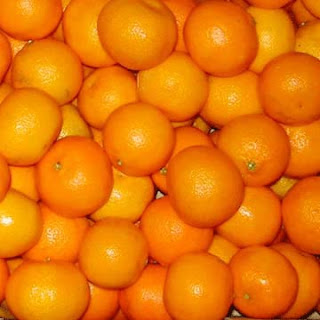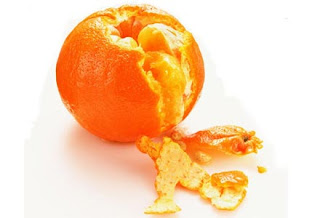AGRICULTURE | Orange | Orange is a hybrid of ancient cultivated origin, possibly between pomelo (Citrus maxima) and mandarin (Citrus reticulata). It is an evergreen flowering tree generally growing to 9–10 m in height (although very old speciments have reached 15 m). The leaves are arranged alternately, are ovate in shape with crenulate margins and are 4–10 cm long. The orange fruit is a hesperidium, a type of berry.
An orange, specifically the sweet orange, is the citrus Citrus × sinensis (Citrus Sinensis (L.) Osbeck) and its fruit. It is the most commonly grown tree fruit in the world.
Orange trees are widely cultivated in tropical and subtropical climates for the delicious sweet fruit, which is peeled or cut (to avoid the bitter rind) and eaten whole, or processed to extract orange juice, and also for the fragrant peel. In 2008, 68.5 million tons of oranges were grown worldwide, primarily in Brazil and the state of Florida in the US.
Oranges probably originated in Southeast Asia and were cultivated in China by 2500 BC. The fruit of Citrus sinensis is called sweet orange to distinguish it from Citrus aurantium, the bitter orange. The name is thought to derive ultimately from the Sanskrit for the orange tree, with its final form developing after passing through numerous intermediate languages.
 |
| Bitter Orange, |
In a number of languages, it is known as a "Chinese apple" (e.g. Dutch Sinaasappel, "China's apple", or northern German Apfelsine). (In English, however, "Chinese apple" generally refers to the pomegranate).
All citrus trees are of the single genus, Citrus, and remain almost entirely interfertile; that is, there is only one "superspecies" which includes grapefruits, lemons, limes, oranges, and numerous other types and hybrids.
Nevertheless, names have been given to the various members of the genus. The name "orange" applies primarily to the sweet orange, Citrus sinensis, which accounts for about 70% of world citrus production. This article is limited to Citrus sinensis and its hybrids.
Other citrus species known as oranges include:
1. The bitter orange, Citrus aurantium, also known as Seville orange, sour orange (especially when used as rootstock for a sweet orange tree), bigarade orange, and marmalade orange.
2. The bergamot orange, Citrus bergamia Risso, which is grown primarily in Italy and used primarily for the peel, which flavours Earl Grey tea.
3. The mandarin orange Citrus reticulata, which itself has an enormous number of cultivars (most notably the satsuma (C. unshiu), tangerine (Citrus × tangerina) and clementine (C. clementina). In some cultivars the mandarin resembles the sweet orange and is difficult to distinguish from it, but it is generally smaller and/or oblate rather than round in shape, easier to peel, and less acid.
4. The trifoliate orange (Poncirus trifoliata) is sometimes included in the genus and classified as an orange (Citrus trifoliata). It is often used as rootstock for sweet orange trees, especially as a hybrid with other Citrus cultivars. The trifoliate orange is a thorny shrub or small tree grown primarily for its foliage and flowers, or as a barrier hedge; however, it bears a downy fruit resembling a small citrus fruit, from which marmalade is sometimes made. It is native to northern China and Korea, and is also known as "hardy orange" (because it can withstand sub-freezing temperatures) or "Chinese bitter orange".
 |
Taxonomy of the orange (and citrus in general) presents difficulties; the interfertility of citrus has resulted in numerous hybrids, bud unions, and cultivars; taxonomy is often controversial, confusing, or inconsistent.
The fruit of a member of the genus Citrus is considered a hesperidium, a kind of modified berry, because it has numerous seeds, is fleshy and soft, derives from a single ovary, and is covered by a rind created by a leathery thickening of the ovary wall. An orange seed is called a "pip". The white thread-like material attached to the inside of the peel is called pith.
 |
Although the sweet orange will grow to different sizes and colours according to local conditions, it most commonly has ten carpels, or segments, inside. Unripe fruit is green. The pebbled exterior of ripe fruit can be bright orange to yellow-orange, but often retains a considerable amount of the green colour of unripe fruit.
 |
Orange trees are generally grafted; the bottom part of the tree, including the roots and trunk, is called the rootstock, while the fruit-producing top part of the tree is called budwood (when talking about the process of grafting) or scion (when talking about the variety of orange).






No comments:
Post a Comment